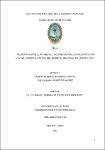Relación entre el PH salival y caries dental en pacientes con VIH del programa targa del Hospital Regional de Loreto, 2014

View/
Date
2014Author
Góngora Cachay, Carlos Alberto
Puerta Ramírez, Iris Julliana
Metadata
Show full item recordAbstract
El presente estudio, tuvo como objetivo establecer la relación entre el pH Salival y el índice de caries en los pacientes con VIH del programa TARGA del Hospital Regional de Loreto, 2014. El tipo de investigación fue cuantitativa; el diseño fue No Experimental, Correlacional, Transversal. La muestra estuvo conformada por 84 pacientes. El instrumento utilizado para identificar el pH salival fue a través de las tiras medidoras de pH, el instrumento para determinar el nivel de Caries dental fue el Índice de CPO, ambos fueron validados por juicio de expertos. Entre los hallazgos más importantes se encontró lo siguiente: El mayor porcentaje de pacientes que participaron en el presente estudio tienen entre 25 y 29 años de edad (61%), el 38% de nuestra población en estudio no contaban con secundaria completa, el 37% provienen del distrito de Iquitos, el 65.5% de pacientes, vienen recibiendo TARGA entre 1 y 5 años y el 59.5% son de Género Masculino. En la presente investigación se ha podido determinar valores del pH Salival con un mínimo de 5 y un máximo de 8 pero el que predominó fue el ÁCIDO seguido por el Neutro y el Básico sucesivamente. El Nivel de CPO en el presente estudio fue de 9.67, teniendo un mayor porcentaje los dientes Cariados, seguidos por los perdidos y los obturados. El Grado de Inmunosupresión con mayor porcentaje fue el Grado 2 (200-500 Linfocitos CD4/μl) y el mayor porcentaje en nivel de Carga Viral fue el Grado I (< 50 000 copias). Se concluye afirmando que SI existe relación entre el Nivel del pH Salival y el Nivel de Caries Dental en pacientes con VIH (p=0.003), evidenciándose que en pacientes con un menor nivel de pH Salival existe un aumento del Nivel de Caries Dental. The present study had the objective to establish a relationship between the pH of saliva and the index of dental caries in patients in the Highly Active Antiretroviral Therapy (HAART) human immunodeficiency virus (HIV) program of the Regional Health of Loreto in 2014. The type of research was quantitative; the design was cross-sectional. The sample included 84 patients. The instrument used to identify pH of saliva was colour-changing pH paper, and the instrument used to determine level of dental caries was the Decayed-Missing-Filled (DMF) index. Both procedures were validated by expert opinion. The most important results that were found include the following: The highest percentage of patients that participated in the present study were between 25 and 29 years of age (61%), 59.5% men, the 38% of the study population did not complete secondary school, 37% were from the district of Iquitos, the 65.5% came to receive come to receive treatment with HAART for a period between 1 to 5 years and the 59.5% are Male. The present research was able to determine values of pH of saliva con a minimum value of 5 and a maximum of 8. However, the most prominent category was ACIDIC, followed by NEUTRAL and then BASIC. The level of DMF in the present study was 9.67, having a high percentage of decayed, followed by missing and then filled. The most prominent grade of immunosuppression was Grade 2 (200-500 lymphocytes cluster of differentiation 4 (CD4/µl) and the most prominent level of viral load was Grade I (<50 000 copies). It was concluded that a relationship exists between the level of pH of saliva and the level of dental caries en patients with HIV (p = 0.003), demonstrating that patients with a low level of pH of saliva have increased levels of dental caries.
Collections
- Tesis [188]
The following license files are associated with this item:

